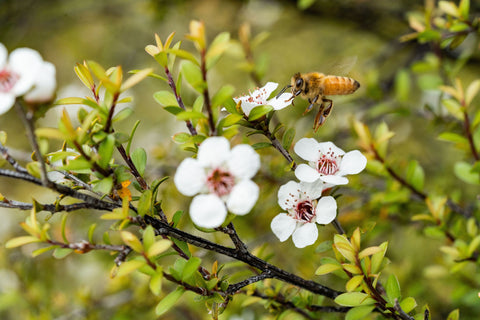Mānuka honey, known for its unique flavor and purported health benefits, has gained popularity in recent years. However, the price tag attached to this golden elixir often leaves consumers questioning why it commands such a high cost. As the demand for Mānuka honey continues to rise, understanding the factors influencing its cost can provide a deeper appreciation for this extraordinary honey and its place in the realm of natural remedies.

Limited Harvest and Production
The Manuka tree blooms for only for 4 to 6 weeks each year, and the bees collect nectar during this short window (December and January, which is summer in New Zealand). The flowers are fragile and all it takes is a storm or strong winds to blow the flowers off the tree. Inclement weather conditions at this time would substantially affect how much honey is produced that season.
The Mānuka flower is not the bee’s preferred floral source, so if it rains and clover flowers, they will pollinate the clover and ignore Mānuka. Beekeepers need to place their hives in the right location to maximize their chance of collecting Mānuka honey. They also need to collect the honey boxes at the right time, before the next floral source appears, or it will not be monofloral Mānuka, which has the most potent wellness properties.
Grading System
The testing required for Mānuka honey to confirm that it is pure, authentic Mānuka Honey is much more expensive than normal honey testing. Further tests are also needed to identify the level of potency.
There are many unique compounds in Mānuka honey but the one most people refer to in relation to the potency is methylglyoxal (MGO). The higher the number, the higher the potency. However, this is only one marker. The gold standard of Manuka Honey is UMF - Unique Mānuka Factor, which measures multiple markers to guarantee freshness, authenticity and potency for the duration of the shelf life. The UMF rating system ranges from UMF5+ to UMF25+, with higher numbers indicating a higher concentration of beneficial compounds. The bees produce only small quantities of the more potent honey, making it a lot more rare.
UMF honey is guaranteed to be packed in New Zealand and meets the very strict compliance regulations to give consumers the peace of mind that they are getting authentic Mānuka Honey from New Zealand which has scientific research behind it.
The grading process involves thorough testing and analysis conducted by independent laboratories. Beekeepers and honey producers invest significant resources in ensuring their Mānuka honey meets the desired UMF standards. Unfortunately, all the additional compliance comes at a cost. The more potent the honey, the higher the grade, and consequently, the higher the price.

Health Benefits
Mānuka honey is renowned for its potential health benefits, which further justifies its high price. The honey's antibacterial and anti-inflammatory properties are attributed to the presence of compounds like MGO. These properties make Mānuka honey a sought-after natural remedy for various health issues, including wound healing, sore throat relief, and digestive issues.
Research has shown that Mānuka honey's antibacterial activity can help combat infections and promote wound healing. Its use in medical settings, such as wound dressings and topical applications, underscores its therapeutic potential. The health benefits associated with Mānuka honey contribute to its premium status and justify the investment for those seeking natural remedies with proven efficacy.
As consumers navigate the world of Mānuka honey, understanding the factors influencing its cost sheds light on the dedication and resources invested by reputable producers. At Taylor Pass Honey, we provide consumers with confidence in the authenticity and purity of our Mānuka honey. While the price tag may seem steep, it reflects the premium quality, meticulous production processes, and the potential health benefits associated with producing genuine Mānuka honey. Find premium, authentic New Zealand Mānuka honey at www.taylorpasshoney.com!


